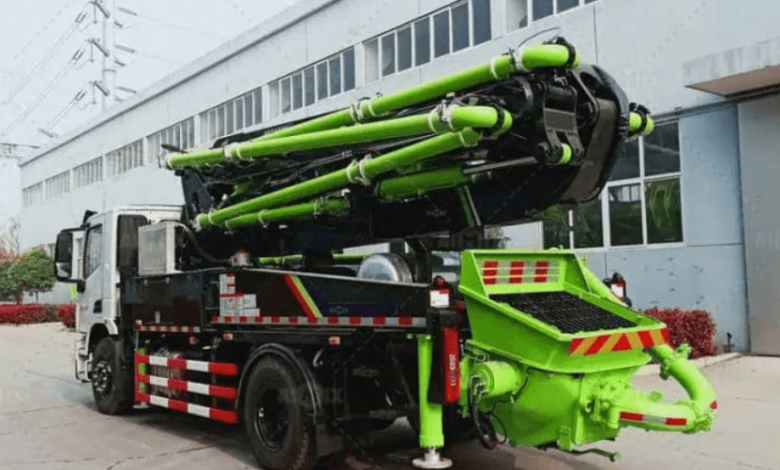concrete pumps: Driving Mega Infrastructure and National Development

Infrastructure is the backbone of any modern economy. Roads, dams, airports, bridges, and tunnels form the foundation on which industries grow and citizens thrive.
Over the years, concrete pumps have emerged as essential equipment in delivering high volumes of concrete with speed, accuracy, and consistency. Whether it’s a dam construction project in a mountainous region or an urban flyover being built over a bustling city, concrete pumps enable engineers and contractors to achieve ambitious targets safely and efficiently.
This article explores the critical role that concrete pumps play in mega infrastructure projects, their engineering benefits, and how they support economic and social development on a national scale.
What are concrete pumps?
These machines have replaced outdated and labor-intensive methods such as manual hauling or crane-and-bucket systems.
There are two main types:
- Line Pumps: Usually trailer-mounted and connected to flexible hoses or steel pipes, line pumps are ideal for horizontal pours across long distances and tight work areas.
Both types play vital roles in infrastructure projects depending on scale, location, and complexity.
See also: Unlocking Cash Flow Success for Small Businesses
Why infrastructure projects need concrete pumps
When it comes to building national-level infrastructure like highways, dams, power plants, or metro systems, time is of the essence. Delays can cost millions and cause widespread disruption. Here’s where concrete pumps make a difference:
1. High-volume delivery
Mega projects often require thousands of cubic meters of concrete in a short time. A modern boom pump can place over 150 m³ per hour, ensuring large-scale pours are completed without interruption.
2. Precision in placement
When pouring into complex formworks such as tunnel linings, bridge decks, or foundation walls, precision is critical.
3. Efficiency in challenging environments
Infrastructure construction frequently takes place in hard-to-access or hazardous areas—such as high altitudes, underwater foundations, or narrow urban zones. concrete pumps can overcome these challenges by reaching areas that traditional machinery cannot.
Examples of mega projects powered by concrete pumps
– Hydropower Dams
Massive hydroelectric dams require millions of tons of concrete. For example, in China’s Three Gorges Dam project and India’s Sardar Sarovar Dam, concrete pumps were vital in transporting and pouring concrete over high-altitude slopes, inside massive spillways, and deep foundations.
– Metro Rail Systems
Building underground tunnels and elevated tracks involves complex concrete placement in limited spaces. Here, boom pumps are used to pour slabs and tunnel linings with high accuracy and without disrupting nearby structures.
– Flyovers and Bridges
Boom pumps are used to pour deck slabs, piers, and columns swiftly and safely—often at night to minimize traffic disruption.
– Runways and Airports
Runway construction involves laying vast concrete slabs over hundreds of meters. Line pumps and boom pumps work in tandem to deliver concrete efficiently, ensuring minimal delays and long-lasting quality.
How concrete pumps reduce project timelines
One of the most significant contributions of concrete pumps to national infrastructure is the drastic reduction in construction time. Unlike conventional methods where concrete had to be moved in batches manually or lifted with cranes, pumps deliver concrete continuously and in real-time.
This:
- Minimizes downtime between pours
- Reduces the need for multiple handling
- Prevents delays due to labor shortages
- Allows work to continue in weather-sensitive or high-risk environments
As a result, projects are completed faster, which leads to cost savings and earlier operational readiness for public use.
Economic impact of concrete pumps on national development
Infrastructure development creates a ripple effect on national economies. Roads, bridges, and power plants create jobs, enhance connectivity, improve trade logistics, and attract foreign investment. In this chain, concrete pumps act as force multipliers.
1. Job creation through faster projects
Faster completion of infrastructure means more projects can be initiated within a fixed time period, creating additional employment opportunities.
2. Reduction in construction costs
Time saved is money saved. By improving productivity and reducing material waste, concrete pumps make infrastructure more cost-effective, allowing governments to do more with the same budget.
3. Boost to construction equipment manufacturing
Increased demand for concrete pumping technology also stimulates local industries and encourages innovation in pump manufacturing, servicing, and operator training.
Environmental advantages in infrastructure
Infrastructure projects often raise concerns about their environmental impact. Fortunately, modern concrete pumps offer environmentally-friendly features:
- Lower emissions: New models meet global emissions standards and some are electric-powered.
- Minimal land disturbance: Unlike cranes or trucks, pumps require less space to operate.
- Precision pouring: Reduces spillage and ensures sustainable use of materials.
- Noise reduction: Especially important for urban infrastructure and nighttime work.
These benefits align with green building standards and government initiatives to promote eco-friendly construction.
Conclusion
In the grand vision of national development, concrete pumps may not make the headlines, but their contribution is undeniable. They are the silent engines powering the infrastructure that supports economies, connects communities, and uplifts nations.
From remote mountain dams to metro networks beneath cities, concrete pumps are indispensable for executing large-scale projects with precision, speed, and sustainability. As the world builds bigger, higher, and smarter, these machines will remain essential tools in constructing the foundation of our future.




